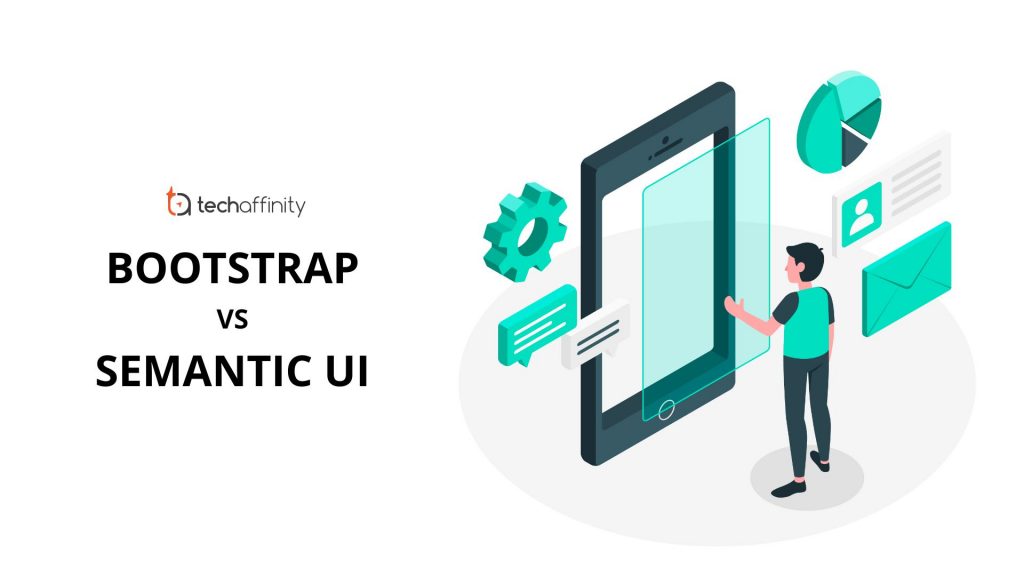Comparison Between Semantic UI & Bootstrap. Decide Which Best Suits your Next Project

Author : John Prabhu 31st Oct 2019

Developing a website or web app needs the support of a perfect framework for that specific project. Often, there prevails a confusion to choose between frameworks as there are numerous frameworks available. Let’s see which is better for your next project: Semantic UI vs Bootstrap.
It is well-known that Bootstrap and Semantic UI are widespread among the developers’ community. Both of them come with unique features and benefits that meet certain requirements. Depending on your goal, you will be making your choice, but this article will highlight the details that will help you make a better decision on Semantic UI vs Bootstrap.
Benefits of Bootstrap Framework – Free & Open-source Framework
Bootstrap frameworkBootstrapBootstrap is a free and open-source CSS framework directed at responsive, mobile-first front-end web development. It contains CSS- and JavaScript-based design templates for typography, forms, buttons, navigation, and other interface components. helps to build responsive, mobile-first sites, and achieve the Device-agnosticDevice-agnosticDevice agnosticism is the capacity of a computing component to work with various systems without requiring any special adaptations. The term can apply to either hardware or software. A device-agnostic peripheral device operates with common computing platforms, typically connecting wirelessly. nature of websites or web apps in no time. It ensures no matter what the screen resolution/dimension of your visitor’s device is, your UI elements will be in place.
The Bootstrap framework consists of font files, CSSCSSCascading Style Sheets is a style sheet language used for describing the presentation of a document written in a markup language like HTML. CSS is a cornerstone technology of the World Wide Web, alongside HTML and JavaScript., and JavaScriptJavaScriptJavaScript, often abbreviated as JS, is a high-level, interpreted scripting language that conforms to the ECMAScript specification. JavaScript has curly-bracket syntax, dynamic typing, prototype-based object-orientation, and first-class functions.. In the year 2016, it began using the “LESS” configuration of components. It means you can hand-pick the features you require for your project from the Bootstrap FrameworkFrameworkA framework is a collection of programs that you can use to develop your own application. It is built on top of a programming language. The framework is a set of pre-written code libraries designed to be used by developers. A programming language is a specified method of communication between the programmer and the computer. instead of installing it completely. This ensures that your website/web app is safe from load time damage.
Some of the significant features of Bootstrap are enlisted below:
Responsive Design: Bootstrap renders the perfect UI components without any deformations in the structure to almost any size of the screen – perfect for the mobile era.
An Array of Themes: With the help of an array of themes available, you can look distinctive and stand a class apart from the rest.
Easy to Customize: There are two ways to customize a bootstrap file. You can either edit .scss files or override the CSSCSSCascading Style Sheets is a style sheet language used for describing the presentation of a document written in a markup language like HTML. CSS is a cornerstone technology of the World Wide Web, alongside HTML and JavaScript. styles.
Quick and Efficient: Each component of the Bootstrap framework ensures performance. As a result, your site will load quickly in a matter of seconds.
Cross-Browser Compatibility: Not all browsers work/function the same way. The grid layout by CSS elements and JavaScript components ensures consistency of your project across browsers with Bootstrap framework.
Phenomenal Documentation Support: With ample illustrations and templates, the documentation is very concise, helpful, and easy-to-use.
Strong Developer Community: If you are having a hard-time in enabling certain functionalities, you can reach out to the incredible Semantic community for support. As it is popular, almost every member of the community would be having solutions to the issues you face.
Customized builds: Bootstrap lets you build your custom build of the framework. What it means is, you can custom pick the CSS elements and JavaScript components for your project. Such practice eradicates the vulnerability of increased load time.
Disadvantages of Bootstrap
Bootstrap relies on the HTMLHTMLHypertext Markup Language is the standard markup language for documents designed to be displayed in a web browser. It can be assisted by technologies such as Cascading Style Sheets and scripting languages such as JavaScript. classes for styling. It is a hint that working with the framework, might at times, get messy. Additionally, Bootstrap bundles a bunch of DOMDOMThe Document Object Model is a cross-platform and language-independent interface that treats an XML or HTML document as a tree structure wherein each node is an object representing a part of the document. The DOM represents a document with a logical tree. elements that are problematic when the project grows due to the struggles in maintaining them.
Unlike Semantic UISemantic UISemantic UI is a modern front-end development framework, powered by LESS and jQuery. It has a sleek, subtle, and flat design look that provides a lightweight user experience. According to the Semantic UI website, the goal of the framework is to empower designers and developers. , Bootstrap comes with only one theme. If you are reluctant to change the styles given in the Bootstrap framework, you are highly likely to end up with a website similar to your competitors. Hence, editing the styles of the theme is mandatory.
Benefits of Semantic UI – A Sleek, Subtle, and Flat Design Look that Provides a Lightweight User Experience
Semantic UI unpacks a variety of themes and CSS, JavaScript, and font files. It is one of the best ways to start designing a page through the semantic method. The semantic method ensures your designs look stunning and bundles a range of components and settings.
More importantly, the package behind Semantic UI is well-organized. You might face little challenges while installing the solution, but it is worth it when you see the results on the screen. Some of the significant features of Semantic UI are enlisted below:
Additional Customization: Undoubtedly, Bootstrap offers ample customization options. But, Semantic UI has got an edge over Bootstrap with extra elements that offer far more options to customize.
Semantic Solutions: Beginners can get along well with Semantic UI as it uses semantic class names for styling the elements. This makes it comparatively simpler and easier to grasp.
Hand-pick your Components: Reduce the file size and thus the load time by choosing only the required components. As the Semantic UI framework is well organized, you can fetch a component established in its file.
More UI Components: You get tons and tons of UI components with Semantic UI, and you can use whichever suits well for your project. These include mobile and responsive solutions.
Incredible Documentation: With sufficient illustrations and documentations, Semantic UI is also easy to learn.
Stunning Designs: Semantic UI unpacks modern and stunning designs that are great while handling different project requirements.
The Problems with Semantic UI
It is recommended to hand-pick only the components that are required for the project because the packages are usually larger. Also, the structure of the framework is comparatively more complicated than Bootstrap. Additionally, some of the Semantic UI users reported bugs within the framework.
Since a lot of features on Semantic UI use JavaScript, there are chances that you might face difficulties if you’re not familiar with JavaScript. Moreover, Semantic UI ships with limited availability of classes.
Understanding the requirement of a project involves comprehending and foreseeing the UX functionalities to the core. Under such circumstances, it is important to choose the right framework that meets the project’s demands.
Having developed various websites/web apps, we are familiar with an array of frameworks. With an understanding of the core benefits and features of frameworks, identifying the suitable framework for the project is easy. Send in your project requirements to media@techaffinity.com, and we will get in touch with you.
